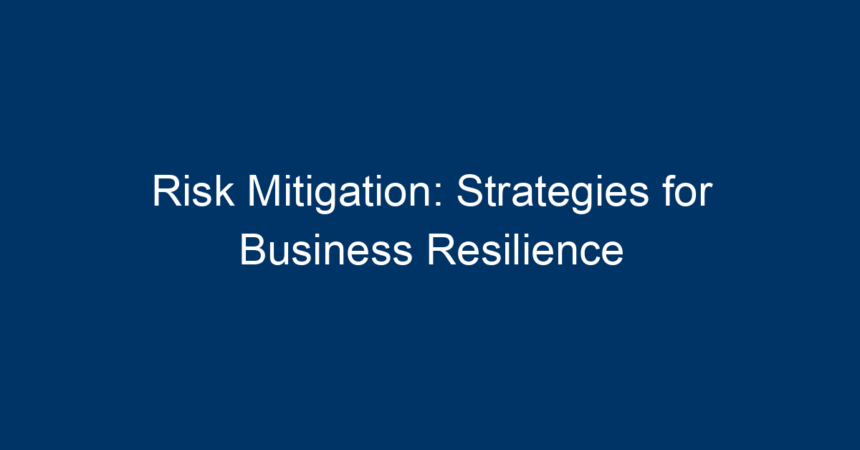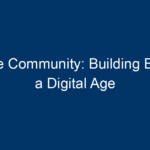In today’s rapidly evolving business landscape, organizations face a myriad of risks—from economic uncertainties and cybersecurity threats to natural disasters and supply chain disruptions. Effective risk mitigation isn’t just about averting disasters; it’s about instilling resilience into the very fabric of a business. Companies that prioritize risk management not only protect their assets but also enhance their long-term viability and competitive advantage. In this article, we will explore comprehensive strategies for risk mitigation that foster business resilience, ensuring that organizations are prepared for whatever challenges lie ahead.
What is Risk Mitigation?
Risk mitigation refers to the process of identifying, assessing, and prioritizing risks followed by coordinated efforts to minimize, monitor, and control the probability or impact of unfortunate events. Rather than merely reacting to crises, a proactive approach involves crafting a robust framework to handle potential setbacks.
The Importance of Risk Mitigation
Understanding the critical nature of risk mitigation is paramount for several reasons:
-
Protects Resources: Effective risk management ensures that financial, human, and material resources are safeguarded against potential losses.
-
Enhances Decision-Making: With a clear understanding of risks, businesses can make informed decisions that align with their strategic goals.
-
Boosts Reputation: Companies that demonstrate robust risk management are viewed as trustworthy and reliable, enhancing their public image and customer loyalty.
-
Regulatory Compliance: Many industries face stringent regulations that necessitate risk assessment and management to avoid legal penalties.
- Encourages Innovation: By addressing potential risks, organizations can pursue new initiatives with greater confidence.
Key Strategies for Effective Risk Mitigation
1. Risk Assessment and Identification
The first step in any risk mitigation strategy is the thorough evaluation of potential risks. This involves:
-
Conducting Risk Assessments: Regularly review all areas of your business to identify vulnerabilities. This may include operational, financial, and strategic risks.
-
Engaging Stakeholders: Collaborate with employees, customers, and partners to gain diverse perspectives on potential risks.
- Utilizing Analytics: Employ data analytics tools to evaluate patterns and predict possible future risks based on historical data.
2. Developing a Risk Management Plan
Once risks have been identified, it’s essential to develop a comprehensive risk management plan that includes:
-
Prioritization of Risks: Rank risks based on their likelihood and potential impact on the organization.
-
Mitigation Strategies: For each identified risk, develop specific strategies for how to minimize its effects. This could include implementing new processes or investing in technology.
- Crisis Response Plan: Create a clear plan for how to respond if a risk materializes. This includes communication strategies, recovery plans, and resource allocation.
3. Building a Culture of Risk Awareness
A culture that prioritizes risk awareness is vital for risk mitigation. This can be achieved by:
-
Training and Education: Provide regular training sessions to employees on risk management best practices. Awareness campaigns can help keep risk considerations at the forefront.
-
Encouraging Transparency: Foster an environment where employees feel comfortable reporting risks without fear of repercussions.
- Setting Examples: Leadership should exemplify risk awareness in their decision-making and encourage a mindset focused on proactive measures.
4. Leveraging Technology for Risk Mitigation
The digital landscape offers various tools and technologies that are invaluable for risk mitigation:
-
Risk Management Software: Implement software solutions that provide real-time insights into risk factors, helping businesses adapt quickly to changing conditions.
-
Cybersecurity Measures: Protect sensitive data through firewalls, encryption, and regular audits to minimize the threat of cyber attacks.
- Cloud Solutions: Utilize cloud-based services for better data backup, disaster recovery, and scalability to respond to unpredictable events.
5. Diversifying Resources and Strategies
Risk mitigation often involves diversification to spread risk across various facets of the business:
-
Supply Chain Diversification: Avoid dependency on a single supplier. Identify multiple sources to ensure a steady flow of materials and services.
-
Service Diversification: Expanding service offerings can create new revenue streams and buffer against market fluctuations.
- Geographic Diversification: Operating in various regions can help mitigate risks related to local economic downturns or political instability.
6. Continuous Monitoring and Review
Risk mitigation is an ongoing effort, requiring constant vigilance and adaptation. To ensure effectiveness:
-
Regular Audits: Conduct regular assessments of your risk management plan to identify areas for improvement.
-
Feedback Mechanisms: Establish systems for collecting feedback on risks from employees and stakeholders to enhance the risk mitigation framework.
- Stay Updated on Trends: Keep abreast of industry trends and emerging threats to adjust your strategies accordingly.
Actionable Insights for Businesses
1. Foster an Agile Business Model
Flexibility is key. To enhance resilience, businesses should strive for an agile model that can quickly adapt to changes— whether that’s implementing new technologies or adjusting operational processes.
2. Invest in Training and Development
Training employees on risk mitigation strategies not only empowers them but also strengthens the organization’s overall resilience. Regular workshops and seminars can keep teams informed and prepared.
3. Utilize Scenario Planning
Scenario planning involves anticipating various potential risks and developing strategies for each situation. This proactive approach allows businesses to stay one step ahead of possible disruptions.
4. Establish Strong Partnerships
Developing strong relationships with suppliers, customers, and partners can provide critical support during crisis situations. Strong networks can facilitate resource sharing and collaborative problem-solving.
Conclusion
Risk mitigation is an integral component of business strategy, playing a crucial role in building resilience. By understanding risks and implementing structured strategies, organizations can effectively protect their assets and ensure long-term success. As the business environment continues to evolve, adapting and refining risk management practices will empower organizations to not only survive in the face of adversity but thrive in a competitive landscape.
In fostering a culture of awareness, leveraging technology, and continuously monitoring risks, businesses position themselves for enduring success. By prioritizing risk mitigation, they can confidently navigate challenges and seize opportunities in an unpredictable world.




